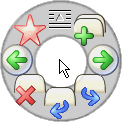Cake menu
In software technology , a cake menu or pie menu (from English pie , a kind of cake or pate ) is a menu that is displayed in a circle around a reference point (for example the mouse pointer or a computer game figure). The options are selected by “pointing” the input device, such as the mouse , in a certain direction. In most cases, pie menus take on the function of a context menu .
As an advantage of pie menus compared to traditional linear pull-down menus, it is often stated that navigating through a graphical user interface is made more efficient, faster and less error-prone, since it is easier to quickly show a direction from one point than one Entry of a drop-down menu. This was scientifically proven by Paul Fitts as early as 1954 . Pie menus have been used in computer programs since the early 1990s.
Occurrence
Despite their advantages, cake menus are still relatively uncommon. This is mainly due to the low availability of standardized program libraries for user interfaces that support this form of interaction. An exception to this is the computer games area, where they have been very widespread for a long time; Examples are The Sims , Silver , Second Life , Secret of Mana , Neverwinter Nights or Crysis .
Graphical user interfaces
So far there are only very few complete desktop surfaces that consistently rely on cake menus. The first window manager to use this feature at least partially was the UDE Window Manager , which has been developed for Unix operating systems since 1998 . The Metisse 3D window manager , which has been included with some Linux distributions since 2007 , also includes pie menus as a functionality. There is a plug-in for the Gnome desktop interface .
In the development of Windows , it has been announced since the late 1990s that they would support pie menus. According to an announcement made by Microsoft in 1999, this feature should already be built into the sixth Windows NT generation (today's Vista ) as part of a redesigned interface , but it was postponed to the seventh generation ( Windows 7 ) expected for 2009 . In Windows 8 and the Modern UI interface, pie menus are increasingly used.
For Windows there is the SmartPie software , which transfers the concept to starting programs and similar actions, or, for example, RadialM , which provides individual functions via pie menus.
Application programs
So far, application programs have only been set up in isolated cases for use with cake menus. Probably the best-known program for which such a functionality is available is the Mozilla Firefox web browser - but as in most other cases it also has to be installed as a plug-in .
In addition, some graphics programs are equipped with cake menus. The Power Animator , a well-known 3D modeling program mainly used in the film industry, was one of the pioneers in introducing this type of menu around 1990.
In the meantime, pie menus can also be found in application programs in a professional environment. The CAD software SolidWorks from version 2010 onwards has a kind of mixture of pie menu and mouse gesture, with which frequently used functions (change views, add lines, circles or rectangles in sketches) can be reached more quickly.
swell
- ^ Don Hopkins: The Design and Implementation of Pie Menus. Archived from the original on January 17, 2010 ; Retrieved July 9, 2015 (English, 1991 article).
- ↑ a b easyGestures N. Add-on for Firefox. addons.mozilla.org, accessed January 7, 2016 .
- ↑ Don Hopkins: Why Pie Menus Aren't Ubiquitous , Infovis.net
- ↑ Article on Neowin.Net about Windows Vienna at that time ( page no longer available , search in web archives ) Info: The link was automatically marked as defective. Please check the link according to the instructions and then remove this notice.
